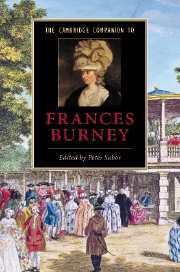Book contents
- Frontmatter
- Introduction
- 1 The Burney family
- 2 Evelina and Cecilia
- 3 Camilla and The Wanderer
- 4 Burney as dramatist
- 5 Journals and letters
- 6 Burney and politics
- 7 Burney and gender
- 8 Burney and society
- 9 Burney and the literary marketplace
- 10 The afterlife and further reading
- Further reading
- Index
- Series List
8 - Burney and society
Published online by Cambridge University Press: 28 September 2007
- Frontmatter
- Introduction
- 1 The Burney family
- 2 Evelina and Cecilia
- 3 Camilla and The Wanderer
- 4 Burney as dramatist
- 5 Journals and letters
- 6 Burney and politics
- 7 Burney and gender
- 8 Burney and society
- 9 Burney and the literary marketplace
- 10 The afterlife and further reading
- Further reading
- Index
- Series List
Summary
The cri du sang or 'call of blood' topos is common in French drama of the seventeenth and eighteenth centuries and in the English novel of the second half of the eighteenth. It was a topos used by Burney in both Evelina (her instant sympathy for Macartney) and The Wanderer (the instant sympathy of Lady Aurora Granville and Lord Melville for Juliet). For use here I would suggest an even more common and corollary topos, the cri de l'âme or 'call of the soul', also commonly used by Burney, in which two superior spirits recognise one another in spite of confusing circumstances. In her novels, though obstacles may intervene, all of Burney's lovers enjoy this rapport. Both these topoi, but particularly the second, depend upon the new hegemonic standard dependent on merit rather than blood, a standard that could instantly propel an individual to equality with aristocrats, to superiority over them. In their lives some of the Burney family were familiar with this recognition. In many ways their careers hung on this new standard.
Apart from the class into which she was born - her father was just struggling to enter the situation of the middling sort - no ambitious young writer could hope to replicate the advantages of Burney's early life. From her first years she mixed with gifted adults of varying character and station. Garrick was a playmate. At Drury Lane she had free access to his box and, familiar with the repertory of plays, could mimic the actors in appropriate diction and style, and invent and enact their further adventures. Her acquaintance, she informed the Queen in 1787, had been very numerous and very mixed, taking in most stations in life and most political parties.
- Type
- Chapter
- Information
- The Cambridge Companion to Frances Burney , pp. 131 - 146Publisher: Cambridge University PressPrint publication year: 2007

